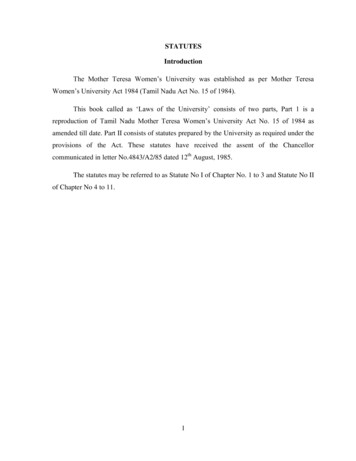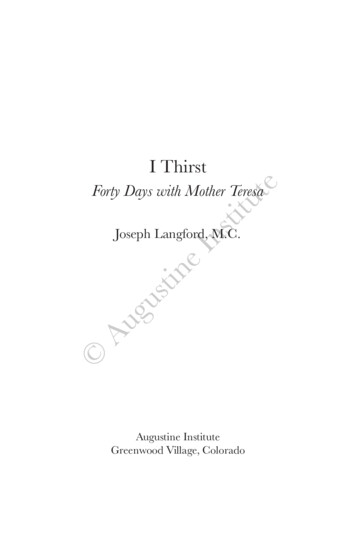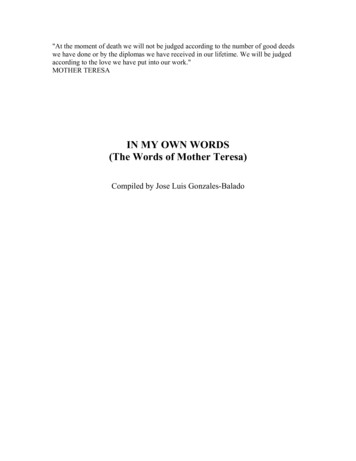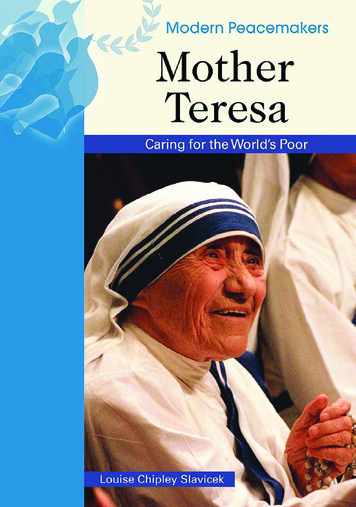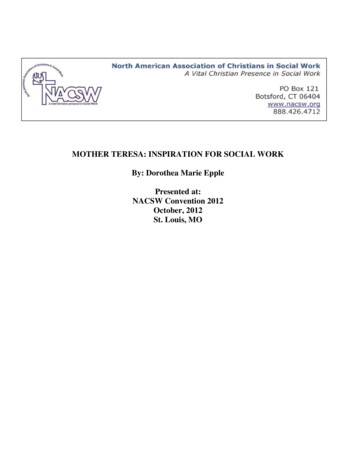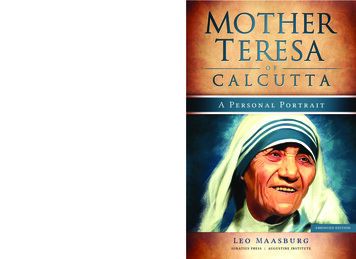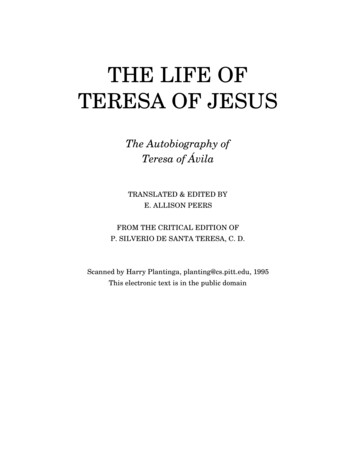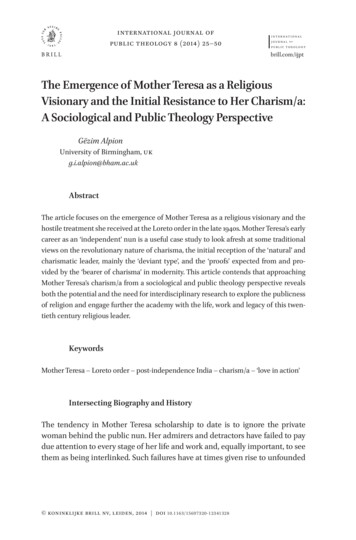
Transcription
International Journal ofPublic Theology 8 (2014) 25–50brill.com/ijptThe Emergence of Mother Teresa as a ReligiousVisionary and the Initial Resistance to Her Charism/a:A Sociological and Public Theology PerspectiveGëzim AlpionUniversity of Birmingham, UKg.i.alpion@bham.ac.ukAbstractThe article focuses on the emergence of Mother Teresa as a religious visionary and thehostile treatment she received at the Loreto order in the late 1940s. Mother Teresa’s earlycareer as an ‘independent’ nun is a useful case study to look afresh at some traditionalviews on the revolutionary nature of charisma, the initial reception of the ‘natural’ andcharismatic leader, mainly the ‘deviant type’, and the ‘proofs’ expected from and provided by the ‘bearer of charisma’ in modernity. This article contends that approachingMother Teresa’s charism/a from a sociological and public theology perspective revealsboth the potential and the need for interdisciplinary research to explore the publicnessof religion and engage further the academy with the life, work and legacy of this twentieth century religious leader.KeywordsMother Teresa – Loreto order – post-independence India – charism/a – ‘love in action’Intersecting Biography and HistoryThe tendency in Mother Teresa scholarship to date is to ignore the privatewoman behind the public nun. Her admirers and detractors have failed to paydue attention to every stage of her life and work and, equally important, to seethem as being interlinked. Such failures have at times given rise to unfounded koninklijke brill nv, leiden, 4 doi 10.1163/15697320-12341328
26Alpionand often fanciful interpretations of some of the key decisions she maderegarding her religious vocation.1‘Neither the life of an individual nor the history of a society’, Charles WrightMills contends in his seminal work The Sociological Imagination, ‘can be understood without understanding both’.2 While Mother Teresa remains one of themost written about twentieth century personalities, on the whole, the overwhelming hagiographic literature as well as almost all the critical works abouther that have appeared since the mid-1990s fail to realize the significance ofMills’ call for the intersection of biography and history. Such an intersection,which is at the heart of what Mills calls ‘the sociological imagination’, is essential for any social study, regardless of its attachment or affinity to any specificdiscipline, to complete ‘its intellectual journey’.3 Mother Teresa’s life enablesus to connect, to use Bauman’s words, the ‘experiences which are lived throughas thoroughly personal and subjective’ and ‘problems fit to be inscribed intothe public agenda and become matters of public policy’.4The sociological imagination, I contend in this article, enables scholars froma variety of disciplines to approach Mother Teresa’s life, work and legacy alsoin the context of ‘social obligations’ and ‘public responsibility’ that were, fromthe start, central to Jürgen Moltmann’s theology. In the concluding chapter ofTheology of Hope, Moltmann writes about different interpretations sociologistsand theologians offer to Christian obedience and resistance in ‘modern, emancipated society’.5 Mother Teresa’s obedience and resistance to her own calling,an issue which will be addressed later in this article, as well as her views on themodern world’s spiritual poverty, are areas that invite cross-disciplinary cooperation especially between sociology and public theology.6To pay due attention to Mother Teresa’s childhood and teenage years inSkopje (1910–1918), the time she spent as a cloistered Loreto nun (1929–1948)1 I identify some of the reasons why Mother Teresa scholarship does not concentrate on theprivate life of the famous nun in Gëzim Alpion, Mother Teresa: Saint or Celebrity? (Abingdonand New York: Routledge, 2007).2 Charles Wright Mills, The Sociological Imagination (Oxford: Oxford University Press, 1999),p. 3.3 Ibid., p. 6.4 Zygmunt Bauman, ‘Sociological Enlightenment: For Whom, About What?’, Theory, Culture &Society, 17:2 (2000), 71–82 at 78–9.5 Jürgen Moltmann, Theology of Hope: On the Ground and the Implications of a ChristianEschatology (London: SCM Press, 1967), p. 305. The book was first published in German in1965.6 See Mother Teresa, Where There Is Love, There Is God: A Path to Closer Union with God andGreater Love for Others, ed. B. Kolodiejuchuk (New York: Doubleday, 2010), pp. 179–80.International Journal of Public Theology 8 (2014) 25–50
The Emergence of Mother Teresa as a Religious Visionary27and the long period during which she was the heart and soul of the Missionariesof Charity order (1949–1997) is to understand better what motivated her tojoin the religious life in the first place, the nature of her charitable activitiesin India and beyond and, in the context of the main thrust of this article, thesource and nature of her charism/a.This article concentrates mainly on the following publications that haveappeared in the wake of her death in 1997: Albert Huart’s article ‘MotherTeresa: Joy in Darkness’; Joseph Neuner’s study ‘Mother Teresa’s Charism’, theedited collection Come Be My Light, which includes excerpts from some of theletters, diaries, notes and other documents Mother Teresa wrote between 1929and 1994; and Where There Is Love, There Is God, an anthology of her practicalteaching and advice.7 In this article I also include for the first time informationfrom the interviews I conducted with Mother Teresa’s relatives in 2011 and 2013.These sources reveal that the charismatic Mother Teresa, who is loved byher admirers and loathed by her opponents, did not come into being when sheentered the religious life at eighteen. She did not learn about charity for thefirst time when she put on the nun’s habit in Dublin in 1928. Mother Teresa,the charitable nun, was the daughter of two charitable parents. Her motherDrane and her father Nikollë were much loved in Skopje for regularly helpingout people in need irrespective of their faith or ethnicity. She witnessed as achild the charitable work of her parents, especially when she visited, with hermother, the houses of the poor, in various parts of Skopje, to bring them foodand clothing.Skopje was also the place where Mother Teresa witnessed for the first timean embodiment of the concept of popularity, or even charisma, as the formeris often referred to today, much to the annoyance of some Weber scholars.8 Thefirst ‘charismatic’ person Mother Teresa met in her life was her father who, as7 Albert Huart, ‘Mother Teresa: Joy in Darkness’, Vidyajyoti Journal of Theological Reflections,64:9 (2000), 645–59; Joseph Neuner, ‘Mother Teresa’s Charism’, Vidyajyoti Journal ofTheological Reflections, 65:3 (2001), 179–92; Mother Teresa, Come Be My Light: The PrivateWritings of the ‘Saint of Calcutta’, ed. B. Kolodiejuchuk (New York: Doubleday, 2007); Teresa,Where There Is Love, There Is God.8 Some Weber scholars take issue with what they consider as commonplace, even banal, appropriation and usage of Weber’s notion of charisma; see Christoph R. Hatscher, Charisma undRes Publica: Max Weber’s Herrschaftssoziologie und die Römische Republik (Stuttgart: FranzSteiner Verlag, 2000), pp. 19–20; and Stephen P. Turner, ‘Charisma Reconsidered’, Journal ofClassical Sociology, 3:1 (2003), 5–26 at 6. Rapoport, on the other hand, argues that ‘[t]hroughWeber charisma has become a common term in our ordinary and academic vocabularies’;see David C. Rapoport, ‘Moses, Charisma, and Covenant’, The Western Political Quarterly, 32:2(1979), 123–43 at 137.International Journal of Public Theology 8 (2014) 25–50
28Alpionwill be seen shortly in this article, had a lasting impact on her life. Nikollë wasan unconventional success story in a town where Albanian Catholics were discriminated against both on the basis of their ethnicity and religion. He helpedto build the railway connecting Skopje with Kosova and the city’s first theatre.In addition, Nikollë was the only Catholic member of the Skopje City Council.For these reasons he was held in high esteem by his fellow Albanians as wellas other communities in Skopje which, in those days, was a multi-ethnic andmulti-religious metropolis. That he was so well known and widely respected isclear from the reaction of his fellow citizens when he died unexpectedly at theage of forty-five.9 All the faiths in the city sent representatives to pay homageto him and all the jewellers closed their shops as a mark of respect on the dayof Nikollë’s grand funeral.Mother Teresa’s widely-travelled father often told her stories about the placeshe had been to in the Balkans, Western Europe and Africa. After his death in1919, Mother Teresa’s main sources of information about the world were booksand the oral and written accounts of several Balkan Slav priests, who narratedtheir experiences as missionaries in India either during their talks in Skopje oron the pages of the Croatian magazine Katolicke misije (Catholic Missions).10Mother Teresa’s narrow world expanded suddenly on 26 September 1928when she left Skopje to embark on her life-changing journey to Dublin viaZagreb, Paris and London. This journey, however, was not a sight-seeing trip,but part of a journey at the end of which she would join the religious life and,as such, be dead to the world.11 Her career choice also meant that the oddswere against her becoming a famous public figure.Mother Teresa spent about six weeks in Dublin at Loreto Abbey atRathfarnham, an Irish convent still housing the order of the Sisters of Loreto,before travelling to India. She arrived in Calcutta at the start of 1929. Apart fromsome carefully selected comments about her efforts to leave the Loreto community in Calcutta, between 1946 and 1948, Mother Teresa’s portrait during the91011For more information on the rise and fall of Nikollë Bojaxhiu, see Alpion, Mother Teresa,pp. 157–8.Mother Teresa is known to have read this publication regularly as a teenager.Becoming a nun is traditionally described as being dead to the world. See MarcelleBernstein, Nuns (Glasgow: Collins, 1978), p. 108. Mother Teresa’s mother and brother Lazarwere initially strongly against her decision to enter the religious life. Lazar went as far assaying to Mother Teresa that in joining an order in India she was burying herself alive inthe middle of nowhere; see David Porter, Mother Teresa: The Early Years (Oxford and NewYork: ISIS Large Print, 1986), p. 29.International Journal of Public Theology 8 (2014) 25–50
The Emergence of Mother Teresa as a Religious Visionary29twenty years she spent as a Loreto nun, like her early life in Skopje, remainslargely fragmented.One can find the main reason why to this day so much about Mother Teresaremains shrouded in mystery in her reluctance to talk about her family and private life, especially the treatment she received at Loreto.12 In addition, MotherTeresa and a number of her trusted Missionaries of Charity are known to haveedited some of the books written by her ghost writers and to have given specific instructions to friendly biographers and hagiographers about what theyshould and should not include about her personal life in their publications.13Charism and CharismaMother Teresa had her critics when she was alive and their number increasedafter her death. On the whole, however, the main bulk of the already vast andever expanding literature about her is essentially of a hagiographic nature.Some of the Jesuit priests who worked closely with her, such as Edward Le Jolyand Joseph Neuner, as well as the majority of Mother Teresa’s friendly biographers are keen to emphasize that her success and popularity derived from theGod-given ‘gift of grace’, as Weber initially called charisma.Mother Teresa authors use two terms—‘charism’ and ‘charisma’—at timesinterchangeably, to highlight what, in their view, is unique about her. ‘Charism’is used primarily by Mother Teresa’s colleagues, spiritual directors and religious authors. Mother Teresa herself uses this term when she refers to what, inher opinion, is essential about her religious order. She writes to the Archbishopof Calcutta Ferdinad Périer, shortly before his retirement in 1960, that she is‘concerned that his successor might not understand and respect the charismof the Missionaries of Charity as he had’.14121314See Kathryn Spink, For the Brotherhood of Man under the Fatherhood of God: Mother Teresaof Calcutta, her Missionaries of Charity and her Co-Workers (Godalming: Colour LibraryInternational, 1981), pp. 16–18; Kathryn Spink, Mother Teresa: An Authorized Biography(New York: HarperOne, 1998), p. 3; and Anne Sebba, Mother Teresa: Beyond the Image(London: Orion, 1997), p. 13.See John Cairns, ‘How this Book Came About’, in L. Vardey, ed., A Simple Path (London:Rider, 1995), pp. 7–12 at pp. 11–12; Spink, Mother Teresa, p. vii; Navin Chawla, MotherTeresa: The Authorized Biography (London: Vega, 2002), pp. vii, xxii, 192–3 and 197; AroupChatterjee, Mother Teresa: The Final Verdict (Kolkata: Meteor Books, 2003), p. 31.Teresa, Come Be My Light, p. 184. Ferdinand Périer was born in Belgium on 22 September1875 and died in India on 10 November 1968. He was Archbishop of Calcutta from1924–1960.International Journal of Public Theology 8 (2014) 25–50
30AlpionDuring her lifetime, Mother Teresa’s charism is cited mainly to explain thesuccess of the Missionaries of Charity order; this tendency continues after herdeath, as is seen in Huart’s article and especially Neuner’s study.15Neuner’s article is the first study by one of Mother Teresa’s most influentialspiritual directors purporting to trace the genesis, evolvement and consolidation of her charism during her lifetime, and its continuation after her death. Byconcentrating mainly on a selection of Mother Teresa’s private writings in the1950s and 1960s, Neuner highlights the inseparable nature of the two dimensions of the nun’s and her religious congregation’s charism: ‘the intimate unionwith Jesus and the work for the poor’.16 The main thrust of Neuner’s argumentis that Mother Teresa’s religious congregation was and remains a tremendoussuccess because she set it up from the first with the purpose of winning soulsfor Jesus.Both Huart and Neuner employ the concept of ‘charism’ also to explainMother Teresa’s dark night of the soul, the full extent of which is revealed onlyafter her death. In an attempt to present her spiritual ordeal as ‘normal’, Huartcontends that ‘[i]t is good traditional teaching that the mystical charism ofGod’s closest friends is meant not primarily for themselves but for the good ofthe whole Church’.17 For his part, Neuner argues that, like all ‘chosen’ individuals, spiritual aridity is a necessary experience for her to come to terms withachievements.On the whole, those who knew Mother Teresa in person prefer to writeof her ‘charism’, a word which in the past was imbued with an otherworldlyaurora, rather than ‘charisma’, for two main reasons. First, their choice reflectstheir disagreement with the pedestrian denotations and connotations thatthe term ‘charisma’ has acquired as a result of the consumerist culture thatdominates our lives, as well as of the ubiquity of that social, cultural and mediaeyesore called ‘celebrity’ that, as Daniel J. Boorstin remarks in 1962, becamethe ‘new kind of eminence’18 in the wake of the Graphic Revolution. Secondly,and more importantly, the preference some Mother Teresa authors have for‘charism’ reflects their disagreement with attempts to equate the celebratednun with other celebrities.191516171819Huart, ‘Mother Teresa’; Neuner, ‘Mother Teresa’s Charism’.Neuner, ‘Mother Teresa’s Charism’, 181.Huart, ‘Mother Teresa’, 659.Daniel J. Boorstin, The Image: A Guide to Pseudo Events in America (New York: Vintage,1992), p. 57.In December 2011 and January 2012, I contacted several individuals who knew MotherTeresa in person to inquire whether ‘charism’ or ‘charisma’ is the most suitable term toInternational Journal of Public Theology 8 (2014) 25–50
The Emergence of Mother Teresa as a Religious Visionary31Different from Mother Teresa’s religious colleagues, most of the biographersand scholars, myself included, who have taken an interest in her, not necessarily for religious motives,20 use ‘charisma’ and not ‘charism’ when referringto her personality, achievements and enduring appeal. Our choice of syntaxis mainly motivated by the tendency to approach this iconic twentieth century religious and humanitarian figure primarily, although not exclusively, inthe context of the celebrity culture discourse and as a result of her ubiquitousmedia presence even after her death. Rightly or wrongly, our tendency to obsessover celebrities and the media played, from the start, a seminal role in generating and sustaining the myth about Mother Teresa as a ‘living saint’;21 a charismatic figure who was and has apparently remained both earthly and ethereal.It appears Mother Teresa attracts, invites and welcomes the attention ofthe media even before she formally sets up the Missionaries of Charity. Inthe late 1940s a Catholic reporter tells a colleague in Calcutta that ‘she’s seeking publicity’.22 While reports about Mother Teresa and her nuns continue toappear in newspapers in Calcutta and across India throughout the 1950s and1960s, it is mainly towards the late 1960s that she attracts the attention of theworld media. The turning point is the interview she gives to the BBC’s MalcolmMuggeridge in London in 1968. A year later Muggeridge travelled to Calcuttato film a BBC programme about her; this was followed by the publication in1971 of Muggeridge’s image-making book Something Beautiful for God.23 InDecember 1975, Mother Teresa became a household name in the United Stateswhen her portrait appeared on the front cover of Time magazine, accompaniedby the caption ‘Messenger of Love and Hope—Living Saints’; the magazine ranthe article ‘Saints Among Us: The Work of Mother Teresa’24 in the same issue.When Mother Teresa was awarded the Nobel Prize for Peace in 1979 her statusas a global media and humanitarian icon was secured.2021222324apply to her. They all believe that a distinction needs to be made between Mother Teresaand celebrities in general and that one way of doing this is through employing ‘charism’and not ‘charisma’ to distinguish what was unique about her personality and why herorder, the Missionaries of Charity, was successful from the start.See Bernstein, Nuns, p. 268.Mother Teresa was hailed as a ‘living saint’ by the media and politicians in India almostfrom the moment she set up the Missionaries of Charity.Desmond Doig, Mother Teresa: Her People and Her Work (London: Collins, 1978), p. 48.Malcolm Muggeridge, Something Beautiful for God: Mother Teresa of Calcutta (London:Collins, 1971).Unattributed article, ‘Saints Among Us: The Work of Mother Teresa’, TIME Magazine,29 December 1975, 45463,00.html [accessed 28 May 2013].International Journal of Public Theology 8 (2014) 25–50
32AlpionThe Unpopular SisterIn this part of the article the focus is not on Mother Teresa the globally recognized public figure and her charismatic appeal but on the years when sheinitially emerged as a visionary nun. I contend that the period between 1946and 1949, before the foundation of the Missionaries of Charity in 1950, merits attention because it reveals that the woman acknowledged as one of themost popular and charismatic individuals in modern times started off as a veryunpopular, even hated figure. What is of interest about her initial unpopularityis that it began when she was a member of the Loreto order.To understand why Mother Teresa decided, in 1946, to leave Loreto, weneed to find out why she chose a religious vocation in the first place. Theprevailing thinking in Mother Teresa scholarship is that she decided to enterthe religious life in 1928 because she wanted to serve Jesus. Equally dominating is the view that she chose to travel as a missionary to India becauseshe wanted to win souls for Jesus by serving the poor of Calcutta. In MotherTeresa: Saint or Celebrity, I contend that her father’s sudden and mysteriousdeath was quite a traumatic event for Mother Teresa who was nine years oldat the time.25 Under the strain of this tragic loss, Mother Teresa was eagerto replace her biological father with a divine father-figure who would neverabandon her.26In light of the private writings of Mother Teresa, released for the first timebetween 2000 and 2010, it appears that her father’s death, which was preceded and followed by at least eight more deaths in her extended family,had a deeper and more intricate impact on her spirituality than previouslythought.27 While these bereavements brought her closer to Jesus as neverbefore, and yet, they also signalled the beginning of her loss of faith in God.In my work in progress on Mother Teresa’s dark night of the soul, I contendthat her decision to go to India was motivated not so much by her desire to252627According to Mother Teresa’s brother Lazar Bojaxhiu, his father was a staunch supporterof the Albanian national cause and his patriotic activity cost him his life. In an interview,which the Italian magazine La Gente ran in December 1979 and January 1980, Lazar madethe claim that his father was poisoned by Serb ultra-nationalists after he had attended ameeting in Belgrade.See Alpion, Mother Teresa, pp. 157–82.I learned for the first time about the large number of deaths to have afflicted MotherTeresa’s extended family as a teenager in Skopje during the interviews with her relativesin 2013.International Journal of Public Theology 8 (2014) 25–50
The Emergence of Mother Teresa as a Religious Visionary33serve Jesus but by an urgent need to escape death and find God.28 MotherTeresa’s quest for the ‘absent’ God lasted until she passed away and it was,apparently to the end, inconclusive.In Mother Teresa’s titanic efforts to rid herself of her spiritual darkness,rather than being an end, the poor were the means she employed to overcomeher spiritual aridity. Moreover, the poor were not her only ‘tools’: Mother Teresaemployed, for the same purpose, the media, her Missionaries of Charity order,and the Co-Workers organization, which was the most important off-shoot ofher religious community, until she disbanded it unexpectedly in 1993, much tothe shock of all concerned.Mother Teresa was always a pragmatic woman and her pragmatism was dictated mainly by the intensity of her trials and tribulations. Further researchinto the relationship between her spiritual quest and pragmatic spirit willthrow more light onto the reasons why, of all the Catholic female orders, shechose to join the Sisters of Loreto in 1928. Likewise, new research will hopefully determine how much Mother Teresa knew, when she made up her mindto enter the religious life, about Mary Ward (1585–1645), the English Catholicnun who founded the Institute of the Blessed Virgin Mary in 1609, and FrancesTeresa Ball (1794–1861), the Irish sister who in 1821 set up the Irish branch of theInstitute in Dublin, which later became known as Loreto Abbey.Given Mother Teresa’s inquisitive nature, one can safely say that she choseto join Loreto in the first place and move to India, immediately after spendingsix weeks at Loreto Abbey, partly because of what she had learnt about thetwo visionary and rebellious foundresses. She decided to go to India apparently thinking that Ward’s and Ball’s vision was being kept alive by the Loretosisters in Calcutta. In view of the nature of Mother Teresa’s rebellion, whichbecame apparent especially from September 1946, and the kind of activitiesshe embarked upon immediately after she left Loreto formally on 16 Augustin 1948, one can conclude that she went to India expecting the Loreto sistersin Calcutta to have maintained Ward’s charism mainly by implementing hertwo visionary calls, articulated some three hundred years earlier. That is, Wardbelieved that nuns should spend less time behind convent walls; she also recommended that sisters should be given more time to serve the needy.28I will shortly submit for publication the first article on Mother Teresa’s spiritual darkness.International Journal of Public Theology 8 (2014) 25–50
34AlpionDisappointment and Soul-SearchingMother Teresa did not have to spend a long time in India to realize that shehad arrived there with false expectations about Loreto. The sisters of Loretolived inside the ‘cosy confines’29 of their convents, or ‘the palace buildings’,30as Mother Teresa put it in her journal entry on 16 February 1949, where theyenjoyed ‘all the beautiful things and comforts’.31 In short, the Loreto nuns,especially those based at Loreto House, were hardly in touch with the poorof Calcutta.Like other fellow Loreto sisters assigned to the convent in the Entally district, Mother Teresa could catch a blurred glimpse of the poor ‘from the window of the classroom block’32 of the convent. The Loreto Convent in Entallywas situated next to Motijhil, one of the slums of the city, which in those dayswas home to Muslims, Hindus and Christians. In spite of its proximity to theconvent, where she had spent almost twenty years, much to the surprise of herfriend Father Julien Henry, by 1948 Mother Teresa still did not know the nameof the slum.33Mother Teresa gradually came to resent the fact that, in line with the Catholicmissionary tradition in India dating back to the nineteenth century, the Loretoorder in Calcutta also had remained essentially an education institution forchildren from privileged backgrounds. In the words of a former Loreto Collegestudent, during the British rule in India ‘Loreto House had admitted very fewIndians’; by the early 1950s the majority of students were ‘the daughters ofCalcutta’s elite families’.34 Some Asian royal families also sent their daughtersto study at Loreto College.35 Mother Teresa’s belief that Loreto had abandonedthe poor was strengthened further when in 1935 she was allowed to leave thecompound to teach at St Teresa’s school, and observe for the first time a grimreality completely different from the sheltered life at the convent.We do not know if Mother Teresa raised her misgivings about what sheapparently came to see as the failures of Loreto when she was a member of this29303132333435M. P. K. Kuttty, ‘Muggeridge, Mother Teresa and her Mission: A Response to Vir Sanghvi’,Catholic Bishops’ Conference of India News, 14 September 2007.Teresa, Come Be My Light, pp. 133–4.Ibid., p. 134.Chawla, Mother Teresa, p. 34.See Porter, Mother Teresa, p. 63.Bharati Mukherjee, ‘Mother Teresa: The Saint’, Time, 14 June 1999, 91258,00.html [accessed 12 January 2012].See Alpion, Mother Teresa, p. 197.International Journal of Public Theology 8 (2014) 25–50
The Emergence of Mother Teresa as a Religious Visionary35order. While she might have shared her views with some of her trusted sistersat the Entally convent, it is unlikely she would have had the opportunity to discuss her concerns with the Loreto superiors who were based at Loreto Housein Calcutta, the headquarters of the Sisters of Loreto in India. Throughout hertwenty years as a Loreto nun, Mother Teresa was based not at Loreto House butat the Entally convent.The fact that Mother Teresa was based, from the first, not at Loreto Housebut at the Entally convent indicates that she was looked down upon by some ofthe Irish nuns who, it appears, always considered her an ‘outsider’. To some ofher superiors, Mother Teresa was not European enough, mainly because of herAlbanian origin.36 In addition to the immorality of the racism in this discrimination, it exposes her superiors’ ignorance to the fact that the Illyrians, the predecessors of the Albanians, first heard about Christianity through Apostle Pauland that they were amongst the first Europeans to convert to the new faith.37Even so, Mother Teresa never mentioned her discrimination at Loreto inpublic. Far from it, she always spoke with fondness about the order and thetime she spent there, even when her relationship with Loreto turned sour.38During her lifetime, the information that she was marginalized and even mistreated at Loreto was very limited. Of particular interest is the account provided by the Indian-American academic Bharati Mukherjee,39 who enrolledat Loreto College in 1951. As Mukherjee reminiscences in 1999, picking up on‘unvoiced opinions of our Loreto nuns’, we believed that Mother Teresa ‘wasn’tas fully European as our Irish nuns’ and we ‘thought her a freak’.40The fact that Mother Teresa was a topic of discussion among the girls studying at the elitist Loreto College, even three years after she had left the order,indicates how badly her superiors took her departure. Further, one can sensethe extent to which Mother Teresa had annoyed her superiors from a ratherunconventional source: the spirit of the vitriolic attacks against Mother Teresais captured with accuracy by the French author Dominique Lapierre in thescript he co-wrote for Kevin Connor’s film Mother Teresa: In the Name of God’sPoor, which was released in 1997.41363738394041For information on the discrimination Mother Teresa experienced at Loreto, on the basisof her Albanian origin, see Alpion, Mother Teresa, pp. 195–9.See (RSV, Rom. 15:19).Teresa, Come Be My Light, p. 143.Mukherjee, ‘Mother Teresa’.Ibid.I am grateful to Gaston Roberge for showing me various scripts of the film In the Name ofGod’s Poor during my visit at St Xavier’s College, Calcutta, India, in the summer of 2005.International Journal of Public Theology 8 (2014) 25–50
36AlpionIn spite of its biographical nature, In the Name of God’s Poor is a feature filmand not a documentary, from which one can draw correct conclusions aboutthe experiences of Mother Teresa’s life that it purports to relay. Given MotherTeresa’s close cooperation wi
Mother Teresa - Loreto order - post-independence India - charism/a - 'love in action' . The book was first published in German in 1965. 6 See Mother Teresa, Where There Is Love, There Is God: A Path to Closer Union with God and Greater Love for Others, ed. B. Kolodiejuchuk (New York: Doubleday, 2010), pp. 179-80.
